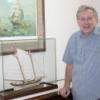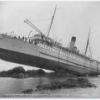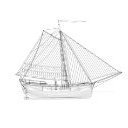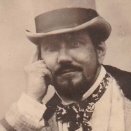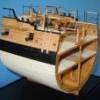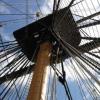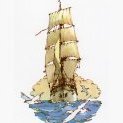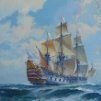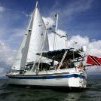Supplies of the Ship Modeler's Handbook are running out. Get your copy NOW before they are gone! Click on photo to order.
×
-
Posts
343 -
Joined
-
Last visited
Reputation Activity
-
 Pete Jaquith got a reaction from schooner in Lucia A Simpson 1875 by cdrusn89 - FINISHED - AJ Fisher - 1/64
Pete Jaquith got a reaction from schooner in Lucia A Simpson 1875 by cdrusn89 - FINISHED - AJ Fisher - 1/64
Gary,
I tried a different approach on my Topsail Schooner Eagle. I slotted every third timberhead into the hull, other timberheads were notched into the covering board, and i planked the bulwarks and upper hull.
-
 Pete Jaquith got a reaction from cdrusn89 in Lucia A Simpson 1875 by cdrusn89 - FINISHED - AJ Fisher - 1/64
Pete Jaquith got a reaction from cdrusn89 in Lucia A Simpson 1875 by cdrusn89 - FINISHED - AJ Fisher - 1/64
Gary,
I tried a different approach on my Topsail Schooner Eagle. I slotted every third timberhead into the hull, other timberheads were notched into the covering board, and i planked the bulwarks and upper hull.
-
 Pete Jaquith got a reaction from No Idea in Buying Filler Blocks
Pete Jaquith got a reaction from No Idea in Buying Filler Blocks
Mikiek,
I have used pine or basswood for filler blocks. Easy to work with but firm enough to provide excellent planking support. Attached are pictures from my Fair American build.
-
 Pete Jaquith got a reaction from catopower in Buying Filler Blocks
Pete Jaquith got a reaction from catopower in Buying Filler Blocks
Mikiek,
I have used pine or basswood for filler blocks. Easy to work with but firm enough to provide excellent planking support. Attached are pictures from my Fair American build.
-
 Pete Jaquith got a reaction from Landlubber Mike in Buying Filler Blocks
Pete Jaquith got a reaction from Landlubber Mike in Buying Filler Blocks
Mikiek,
I have used pine or basswood for filler blocks. Easy to work with but firm enough to provide excellent planking support. Attached are pictures from my Fair American build.
-
 Pete Jaquith got a reaction from thibaultron in Buying Filler Blocks
Pete Jaquith got a reaction from thibaultron in Buying Filler Blocks
I used 1/8", 1/4" 1/2" and 3/4" basswood sheet laminated for the bulkhead spacing for filler blocks. If basswood is not available, I would use pine or popular. Shaping was done with #80 grit paper wrapped around 1" and 1.5" dowels. They turned out to be very effective fairing tools rapidly removing unneeded material. This was followed by #120 and #150 grit paper using the same large dowels.
After initial shaping with gouges and chisels, I use the same large dowels for fairing laminated solid hulls.
-
 Pete Jaquith got a reaction from Ryland Craze in Buying Filler Blocks
Pete Jaquith got a reaction from Ryland Craze in Buying Filler Blocks
Mikiek,
I have used pine or basswood for filler blocks. Easy to work with but firm enough to provide excellent planking support. Attached are pictures from my Fair American build.
-
 Pete Jaquith got a reaction from Snug Harbor Johnny in Buying Filler Blocks
Pete Jaquith got a reaction from Snug Harbor Johnny in Buying Filler Blocks
Mikiek,
I have used pine or basswood for filler blocks. Easy to work with but firm enough to provide excellent planking support. Attached are pictures from my Fair American build.
-
 Pete Jaquith got a reaction from thibaultron in Buying Filler Blocks
Pete Jaquith got a reaction from thibaultron in Buying Filler Blocks
Mikiek,
I have used pine or basswood for filler blocks. Easy to work with but firm enough to provide excellent planking support. Attached are pictures from my Fair American build.
-
 Pete Jaquith got a reaction from mikiek in Buying Filler Blocks
Pete Jaquith got a reaction from mikiek in Buying Filler Blocks
Mikiek,
I have used pine or basswood for filler blocks. Easy to work with but firm enough to provide excellent planking support. Attached are pictures from my Fair American build.
-
 Pete Jaquith got a reaction from dvm27 in Buying Filler Blocks
Pete Jaquith got a reaction from dvm27 in Buying Filler Blocks
Mikiek,
I have used pine or basswood for filler blocks. Easy to work with but firm enough to provide excellent planking support. Attached are pictures from my Fair American build.
-
 Pete Jaquith got a reaction from mtaylor in Buying Filler Blocks
Pete Jaquith got a reaction from mtaylor in Buying Filler Blocks
Mikiek,
I have used pine or basswood for filler blocks. Easy to work with but firm enough to provide excellent planking support. Attached are pictures from my Fair American build.
-
 Pete Jaquith got a reaction from sonicmcdude in block fillers at the bow
Pete Jaquith got a reaction from sonicmcdude in block fillers at the bow
Hi Michael,
In my 14 Gun Brig "Fair American" build (here on MSW) I choose to use filler blocks to assist in hull fairing as well as providing improved support for planking. Filler blocks were bass wood glued to the bulkheads prior to hull assembly. Fairing was accomplished using 60 grit sandpaper wrapped around hardwood dowels. This approach was successful in providing a well faired hull from an inaccurate set of kit furnished bulkheads. I wood recommend bass wood or pine for filler blocks as its easy to work with but strong enough to support planking.
Regards,
Pete
-
 Pete Jaquith got a reaction from David659 in Brig Fair American circa 1780 by Pete Jaquith - Model Shipways - 1:48 scale
Pete Jaquith got a reaction from David659 in Brig Fair American circa 1780 by Pete Jaquith - Model Shipways - 1:48 scale
Welcome to the 14 Gun Brig "Fair American" circa 1780 build log,
Continuing with the transom planking, key points include:
>>> Counter planking was straight
>>> Counter/transom plank widths to suit conditions
>>> Transom planking laid out with cambered planks (by eye)
>>> Transom planking cut from sheet stock
>>> Transom planking cut with aid of ship's curves
>>> Transom windows formed to follow curve of transom planking
Pete Jaquith
Shipbuilder
-
 Pete Jaquith got a reaction from Archi in Double planking a hull: pros and cons
Pete Jaquith got a reaction from Archi in Double planking a hull: pros and cons
Bruce,
I prefer to single plank. That said, with single planking it is important to carefully fair the hull and ensure adequate support for planks in areas of significant curvature. As Kurt noted, the number of bulkheads is a key factor. The following pictures from my "Fair American" build show how I filled in between bow and stern bulkheads to help fair this hull and provide more planking support.
Pete
-
 Pete Jaquith got a reaction from R_Davey in Double planking a hull: pros and cons
Pete Jaquith got a reaction from R_Davey in Double planking a hull: pros and cons
Bruce,
I prefer to single plank. That said, with single planking it is important to carefully fair the hull and ensure adequate support for planks in areas of significant curvature. As Kurt noted, the number of bulkheads is a key factor. The following pictures from my "Fair American" build show how I filled in between bow and stern bulkheads to help fair this hull and provide more planking support.
Pete
-
 Pete Jaquith got a reaction from Stevenleehills in Constitution by Geoff Matson - Model Shipways 2040 - 1/76 scale
Pete Jaquith got a reaction from Stevenleehills in Constitution by Geoff Matson - Model Shipways 2040 - 1/76 scale
Tapering the quarterdeck planks on my Fair American was worthwhile and not that difficult.
Shipbuilder. Images 127 & 131 show the quarterdeck and Image 132 shows the process.
-
 Pete Jaquith got a reaction from Geoff Matson in Constitution by Geoff Matson - Model Shipways 2040 - 1/76 scale
Pete Jaquith got a reaction from Geoff Matson in Constitution by Geoff Matson - Model Shipways 2040 - 1/76 scale
Tapering the quarterdeck planks on my Fair American was worthwhile and not that difficult.
Shipbuilder. Images 127 & 131 show the quarterdeck and Image 132 shows the process.
-
 Pete Jaquith got a reaction from Der Alte Rentner in Constitution by Geoff Matson - Model Shipways 2040 - 1/76 scale
Pete Jaquith got a reaction from Der Alte Rentner in Constitution by Geoff Matson - Model Shipways 2040 - 1/76 scale
Tapering the quarterdeck planks on my Fair American was worthwhile and not that difficult.
Shipbuilder. Images 127 & 131 show the quarterdeck and Image 132 shows the process.
-
 Pete Jaquith got a reaction from Roger Pellett in Eagle 1847 by Pete Jaquith - FINISHED - Topsail Schooner
Pete Jaquith got a reaction from Roger Pellett in Eagle 1847 by Pete Jaquith - FINISHED - Topsail Schooner
Thank you for your interest and complements.
I enjoy studying these ships and in particular these examples of merchant sail from the mid 1800's. It is also a joy to reproduce a likeness of these beautiful ships with my own hands.
Regards,
Pete
-
 Pete Jaquith got a reaction from Roger Pellett in Eagle 1847 by Pete Jaquith - FINISHED - Topsail Schooner
Pete Jaquith got a reaction from Roger Pellett in Eagle 1847 by Pete Jaquith - FINISHED - Topsail Schooner
Welcome to the Topsail Schooner "Eagle" 1847 build log,
Finishing up the running rigging and final pick up, key points include:
>>> Final drops of thinned white glue to secure rigging lines
>>> Rigging coils installed
>>> Ship's boat secured
>>> Final paint touchup
>>> Model cased and mounted in brass pedestals
The model now rests in the home of a dear friends in the State of Maine. They are Maine natives, which is appropriate for this ship is typical of Maine coastal traders of the mid 1800's.
Pete Jaquith
Shipbuilder
-
 Pete Jaquith got a reaction from Roger Pellett in Eagle 1847 by Pete Jaquith - FINISHED - Topsail Schooner
Pete Jaquith got a reaction from Roger Pellett in Eagle 1847 by Pete Jaquith - FINISHED - Topsail Schooner
Welcome to Topsail Schooner "Eagle" 1847 build log,
The Topsail Schooner "Eagle" 1847 is a 3/16" scale plank on solid scratch build. The construction sequence is similar to my "Newsboy" 1854 build. The hull was carved from basswood laminations. Key Points include:
>>> Laminations were glued (dark wood glue) and doweled together
>>> Deck shear and camber was carved 1st
>>> Poop deck lifts were left loose until the fore deck was complete
>>> Inverted hull was attached to a building board giving a common base for hull templates
>>> Upper hull was recessed 3/64" for hull planking (lower hull will be coppered)
>>> Stem, keel, stern post, and rudder were fitted
>>> Mounting pedestals were fitted and mounting holes drilled
Pete Jaquith
Shipbuilder
-
 Pete Jaquith got a reaction from Bill Morrison in Red Jacket by MrBlueJacket - FINISHED - BlueJacket Shipcrafters - Scale 1/8" = 1' (1:96)
Pete Jaquith got a reaction from Bill Morrison in Red Jacket by MrBlueJacket - FINISHED - BlueJacket Shipcrafters - Scale 1/8" = 1' (1:96)
Personally, I prefer plank on solid (POS) to plank on frame (POF) construction. I have used both machine carved kit hulls and laminated scratch built hulls. The following notes apply:
Machine Carved Hulls
Requires care in establishing reference lines May require hull, deck, and/or bulwark build up Hull carved inverted using reference board and templates Hull initially carved to outer plank lines Upper hull recessed for 3/64" planking, lower hull coppered Thinning carved bulwarks requires care, they may be replaced with built up bulwarks Reference my Brigantine Newsboy build log on MSW Laminated Scratch Built Hulls
Ease in establishing/maintaining reference lines Maintain rectangular configuration until completion of deck carving, deck layout, and drilling of mast holes Hull carved inverted using reference board and templates Hull initially carved to outer hull lines Upper hull recessed for 3/64" planking, lower hull coppered Requires built up bulwarks with timberheads slotted into hull block Reference my Topsail Schooner Eagle build log on MSW I find both techniques work well and require ~ 60 hours for hull carving
Regards,
Pete
-
 Pete Jaquith got a reaction from Ingo in Type of wood for filler blocks?
Pete Jaquith got a reaction from Ingo in Type of wood for filler blocks?
Matt,
I have had good experience with filler blocks, both to assist in hull fairing and to support planking. I recommend something firmer than balsa such as bass, pine, or popular. I have attached pictures of my Fair American build for reference.
Regards,
Pete
-
 Pete Jaquith got a reaction from KeithAug in Arethusa 1907 by Elia - Knockabout Banks Fishing Schooner
Pete Jaquith got a reaction from KeithAug in Arethusa 1907 by Elia - Knockabout Banks Fishing Schooner
Elia,
Nice looking spars and rigging ironwork. I look forward to seeing your work on silkspan sails as I plan to go that way for future builds.
Regards,
Pete


